Article begins
The collaborative process of graphic ethnography is illuminated by the creative journey of Alisse Waterston and Charlotte Corden as they plan, write, and illustrate a book for publication.
This piece of graphic ethnography can also be viewed as two larger images laid out in a four page spread: pages one and two, pages three and four.

Image description: On a dark background mimicking a sky, bright text reads “Making Light in Dark Times, The Human Search for Meaning, written by Alisse Waterston, illustrated by Charlotte Corden.” Books fly across the dark sky illuminated with streams of light. The avatars of the author, Alisse, and the artist, Charlotte, stand and sit atop an open book, flying across the world as if on a magic carpet. The former is wearing a red shirt and the latter is wearing a blue shirt, which is carried throughout the comic.
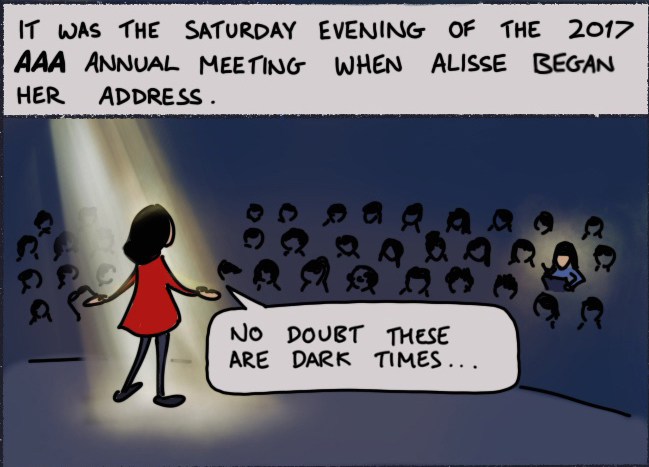
Image description: The narrative text reads “It was the Saturday evening of the 2017 AAA Annual Meeting when Alisse began her address.” Alisse’s avatar stands on stage, a beam of light shining down on her as she faces an audience that includes artist Charlotte , shown here in her avatar. Alisse is saying “No doubt these are dark times…”
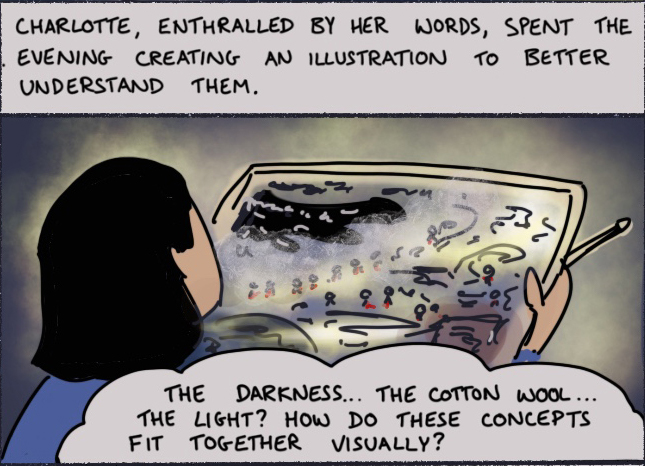
Image description: The narrative text reads: “Charlotte, enthralled by her words, spent the evening creating an illustration to better understand them.” Charlotte draws on her iPad with the light as golden and the dark in all its fury while thinking, “The darkness… the cotton wool… the light? How do these concepts fit together visually?”
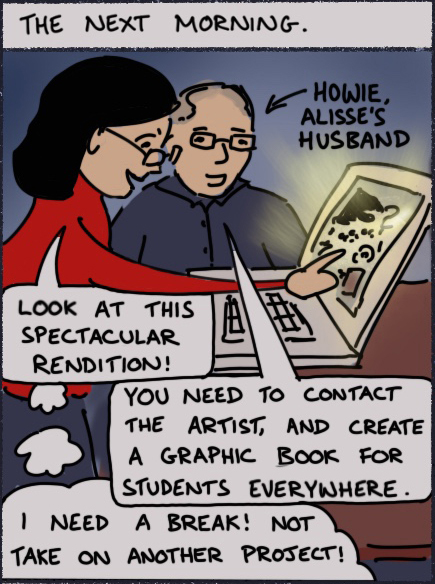
Image description: The narrative text reads “The next morning.” Alisse and her husband view Charlotte’s illustration on her computer screen and converse. Alisse says, “Look at this spectacular rendition!” Looking over her shoulder, Alisse’s husband suggests, “You need to contact the artist, and create a graphic book for students everywhere.” In response to this, Alisse thinks “I need a break! Not take on another project!”
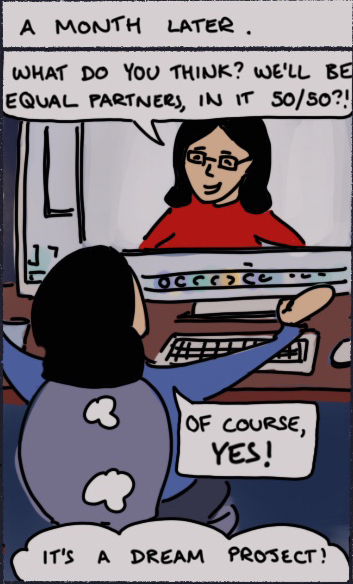
Image description: The narrative text reads “A month later:” Alisse and Charlotte talk through their computers, with Charlotte facing Alisse who appears on the screen. Alisse says, “What do you think? We’ll be equal partners, in it 50/50?!” Charlotte replies, “Of course, yes!” and thinks “It’s a dream project!”
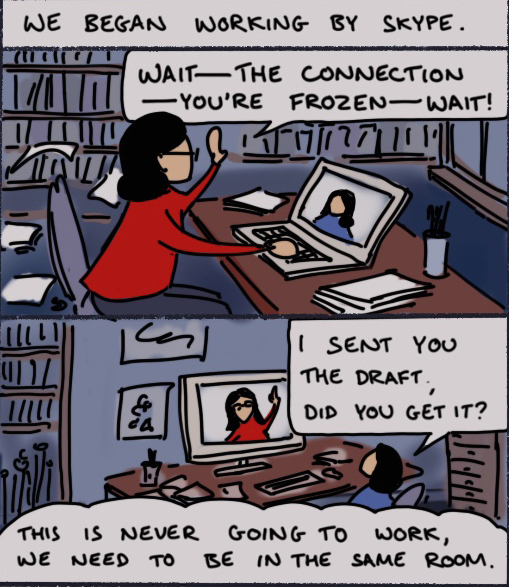
Image description: The narrative text for reads “We began working by Skype.” Alisse and Charlotte are both sitting at their own computers in separate offices, struggling together with the online process. They are having a conversation via their computers. Alisse exclaims, “Wait—the connection—you’re frozen—wait!” Meanwhile, Charlotte says, “I sent you the draft. Did you get it?” and then thinks “This is never going to work. We need to be in the same room.”

Image description: The narrative text reads “So in June 2018, Charlotte took to the sky.” Arms up in the air, Charlotte hangs out the window of the airplane flying in the clouds. She is thinking, “Woohoo! New York, New York!”
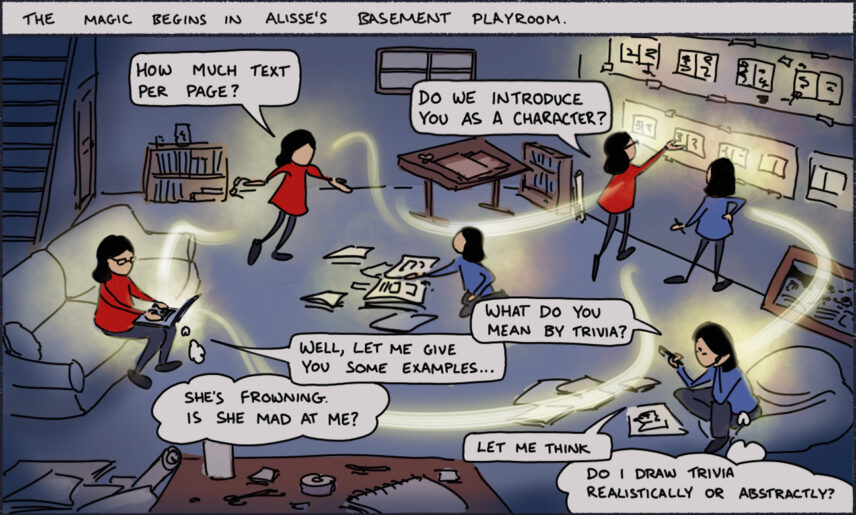
Image description: The narrative text reads “The magic begins in Alisse’s basement playroom.” Alisse and Charlotte are working dizzyingly, sitting, talking, moving around surrounded by the storyboard sheets that are pasted across the basement wall amid toys, tables, the couch, books and art supplies. Their conversations and thoughts are shared in speech and thought bubbles.
Alisse: How much text per page? Do we introduce you as a character?
Charlotte: What do you mean by trivia?
Alisse: Well, let me give you some examples.
Charlotte: Let me think…
Alisse (thought bubble): She’s frowning. Is she mad at me?
Charlotte (thought bubble): Do I draw trivia realistically or abstractly?
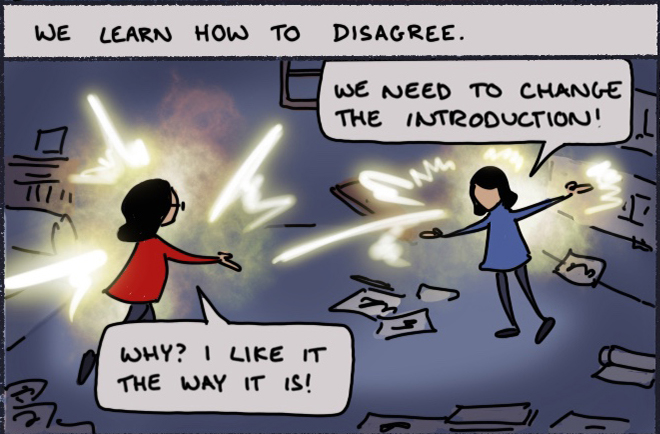
Image description: The narrative text reads “We learn how to disagree.” Alisse and Charlotte talk amid the drawing papers with their arms spread wide in the middle of gesturing as streams and sparkles of light surround them. Charlotte is saying, “We need to change the introduction!” and Alisse replies, “Why? I like the way it is!”
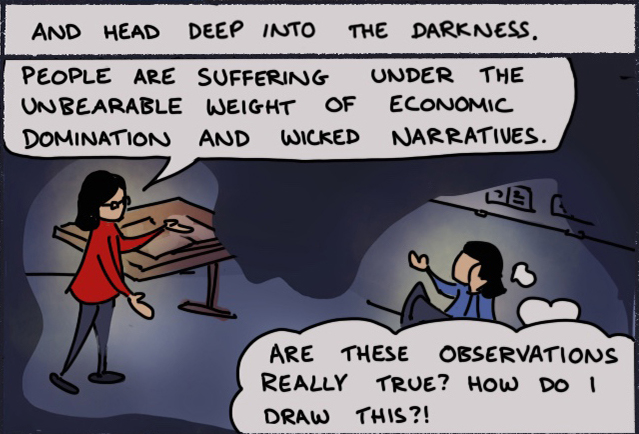
Image description: The narrative text reads “And head deep into the darkness.” As the two work, darkness descends, hovering over them and the space where their creative encounter is taking place. Alisse says, “People are suffering under the unbearable weight of economic domination and wicked narratives.” Head on her hand, Charlotte thinks, “Are these observations really true? How do I draw this?!”
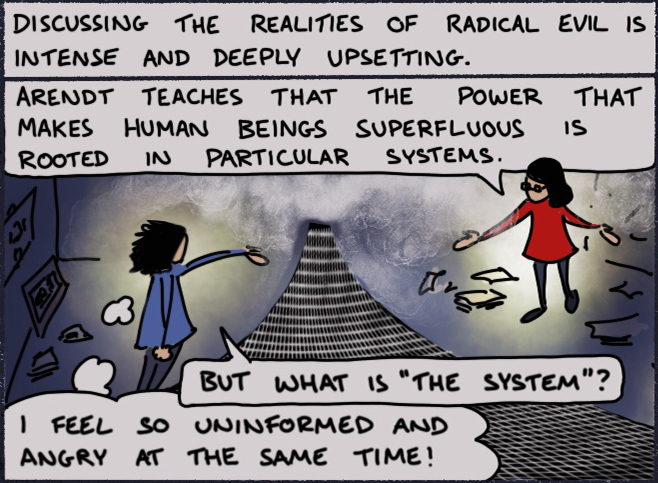
Image description: The narrative text reads “Discussing the realities of radical evil is intense and deeply upsetting.” Alisse and Charlotte stand in a room, engaging in a discussion, arms lifted in mid-gesture. Alisse says “Arendt teaches that the power that makes human beings superfluous is rooted in particular systems.” In response, Charlotte asks for clarification, “But what is ‘the system’?” while thinking “I feel so uninformed and angry at the same time!” An excerpt of the abstract illustration of “the system” backgrounds their dialogue and their thoughts.
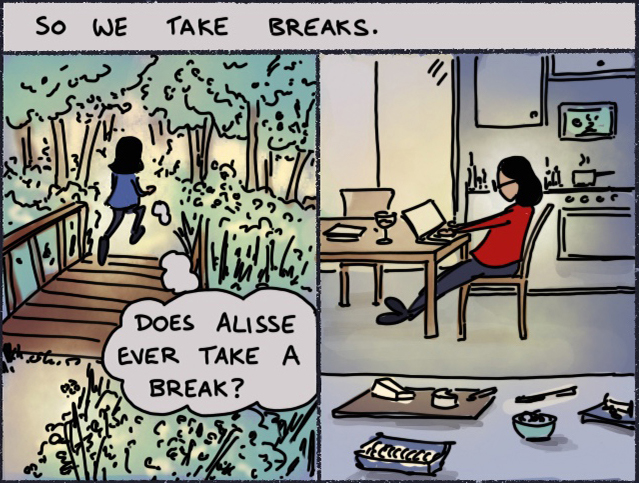
Image description: The narrative text reads “So we take breaks.” Charlotte is on a run outdoors through a path in the woods, wondering to herself “Does Alisse ever take a break?” Meanwhile, Alisse sits at her kitchen table, working on the computer with a wine glass and book nearby.
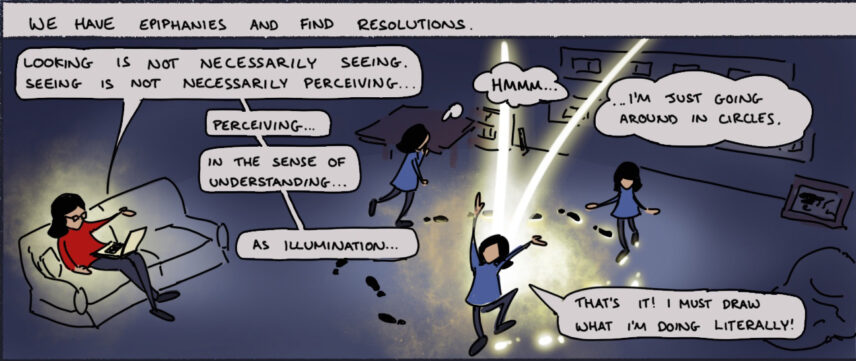
Image description: The narrative text reads “We have epiphanies and find resolutions.” Back in the basement, the artist who paces and the author who sits, computer in hand, continue their dialogue. Charlotte’s footprints are shown pacing in the circle that facilitates her epiphany, shown with a burst of light. Alisse says, “Looking is not necessarily seeing. Seeing is not necessarily perceiving… Perceiving… in the sense of understanding…as illumination…” Charlotte ponders to herself, “Hmmm… I’m just going around in circles.” Then as her epiphany hits, she shouts, “That’s it! I must draw what I’m doing literally!”
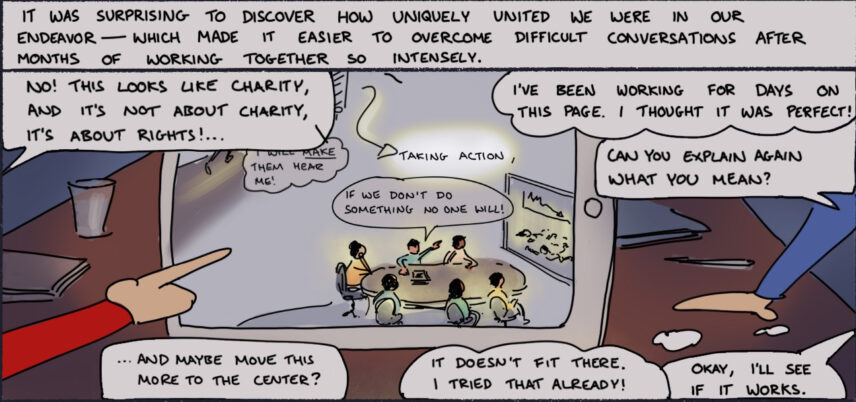
Image description: The narrative text above the artwork reads “It was surprising to discover how uniquely united we were in our endeavor—which made it easier to overcome difficult conversations after months of working together so intensely.” As they converse, Alisse’s arm and hand are shown, her finger pointing at the computer screen that holds the illustration being discussed while Charlotte’s arm and hand are shown resting on the table, her pencil nearby. Alisse says “No! This looks like charity, and it’s not about charity, it’s about rights!” Charlotte thinks, “I’ve been working for days on this page. I thought it was perfect!” but aloud she says, “Okay. Can you explain again what you mean?” Then Alisse adds, “…and maybe move this more the center?” In response, Charlotte thinks to herself, “It doesn’t fit there. I tried that already,” but responds with “Okay, I’ll see if it works.”
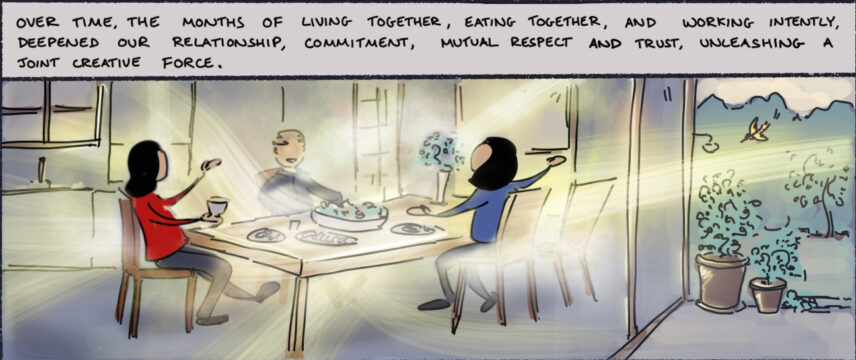
Image description: The narrative text reads Over time, the months of living together, eating together, and working intently, deepened our relationship, commitment, mutual respect and trust, unleashing a joint creative force.” Charlotte, Alisse and Alisse’s husband are sitting at the kitchen table, eating, drinking and engaged in lively conversation with a view of a lovely patio and yard. The golden light swirls around them, reflecting warmth and connection.
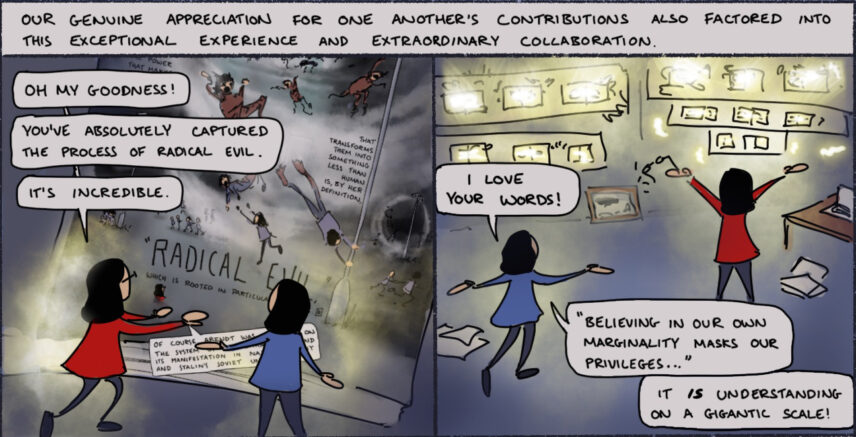
Image description: The narrative text reads “Our genuine appreciation for one another’s contributions also factored into this exceptional experience and extraordinary collaboration.” Alisse and Charlotte stand in front of Charlotte’s illustration of radical evil, drawn as humans transformed into inhuman, rat-like creatures. Alisse says “Oh my goodness. You’ve absolutely captured the process of radical evil. It’s incredible.” Beside this there is a scene of Charlotte and Alisse gazing on the wall of words and illustrations with their arms lifted. Both are illuminated with the light that reflects their collaboration and the entire enterprise. Charlotte exclaims, “I love your words! ‘Believing in our own marginality… masks our privileges…’ It is understanding on a gigantic scale!”
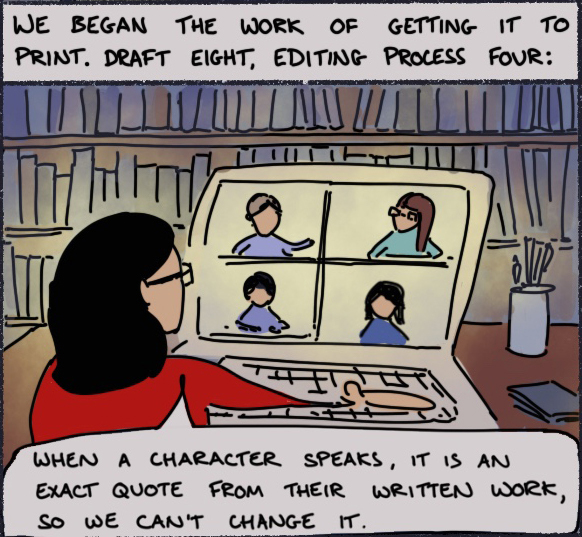
Image description: The narrative text reads “We began the work of getting it to print. Draft eight, editing process four:” Alisse is shown in her library office at her computer on a zoom call with Charlotte and the publishing team, and is saying “When a character speaks, it is an exact quote from their written work, so we can’t change it.”
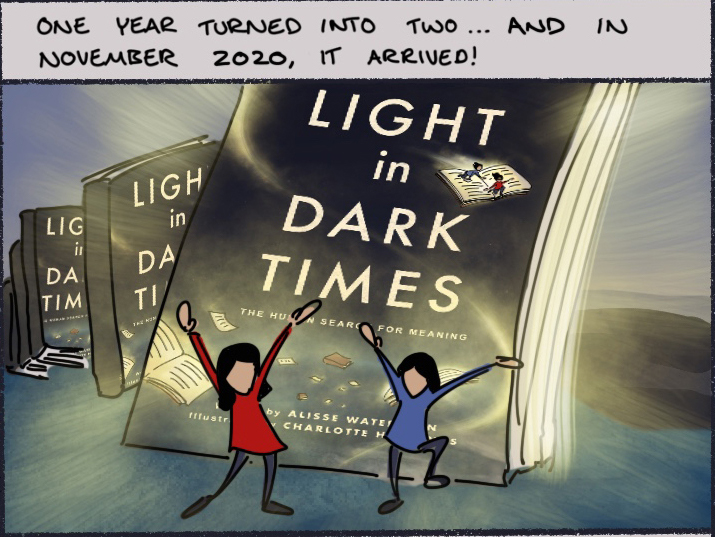
Image description: The narrative text reads “One year turned into two… and in November 2020, it arrived!” Charlotte and Alisse appear in front of several copies of the final book standing one near the other, each shown with an illustration of the book cover. The author and the artist have their arms up in excitement and joy.
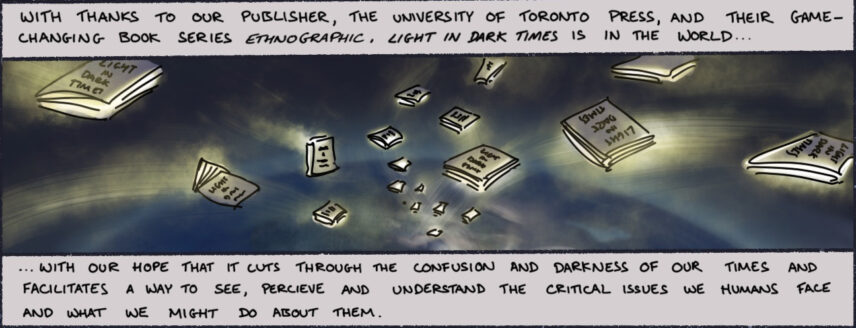
Image description: The narrative text at the top of the panel reads “With thanks to our publisher, the University of Toronto Press, and their game-changing book series, ethnoGRAPHIC, Light in Dark Times is in the world…” In a dark sky illuminated with golden light, the book is floating and flying across the world. Then the narrative text below the illustration continues “…with our hope that it cuts through the confusion and darkness of our times and facilitates a way to see, perceive, and understand the critical issues we humans face and what we might do about them.”

